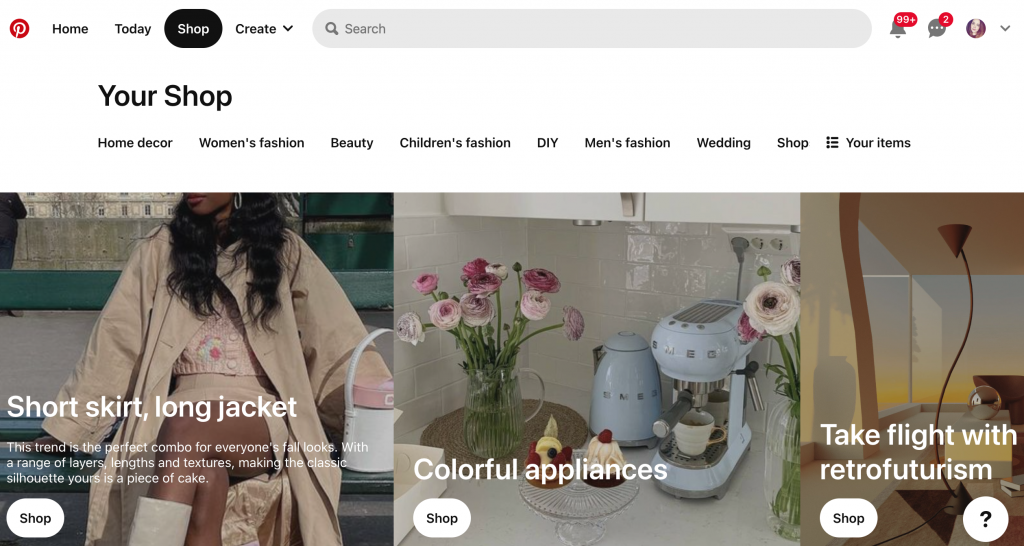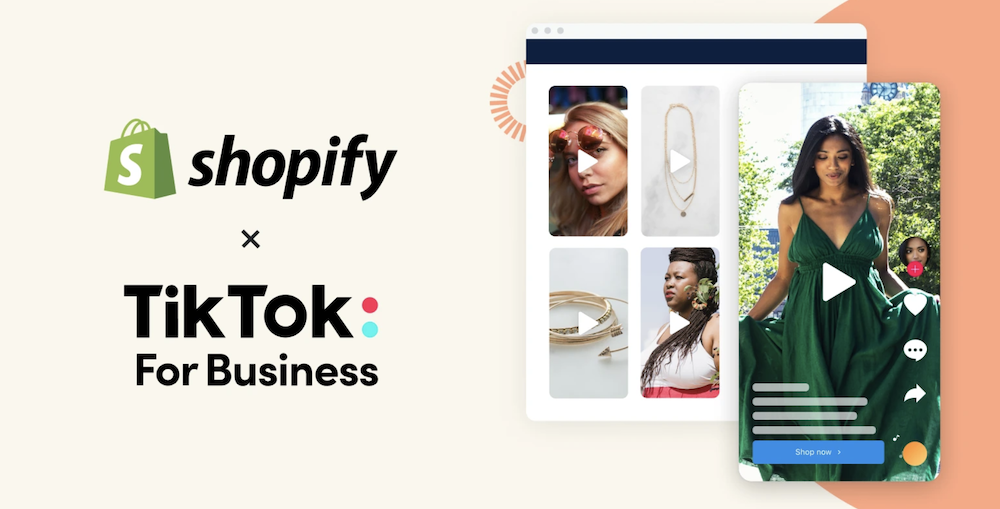Social media platforms are making it easier for brands to sell products on their apps — here’s why your e-commerce company should hop on board.
Here you’ll learn:
- How social media e-commerce has evolved
- What e-commerce looks like on a variety of social platforms
- Ways to improve your social selling game
- The latest stats on social commerce
In response to the global pandemic, online shopping experienced a remarkable boost. While overall purchase power declined, millions of people opted to shop virtually over shopping in their brick-and-mortar counterparts.
Not only did this breathe new life (and competition) into the e-commerce space in the years since 2020, but social media platforms took notice.
As a result, many of the most popular social channels added new features to enable e-commerce brands to sell more easily through their apps, also called social selling, social shopping, or social commerce.

It’s clear that m-commerce and social media will have a big impact on the future of online shopping. (Image: Unsplash)
What is social commerce?
Social commerce is the act of a consumer being able to shop and purchase products via a social media platform or app. This process, steps, and experience will be slightly different depending on the brand and the platform.
Some platforms allow shoppers to make a purchase directly within an app they’re using, while others guide the user to a product page on the brand’s website. We’ll dig into all the ways social commerce works below.
The rise of shopping on social media
There has been a ton of progress made in the social commerce space in the last few years alone.
Instagram Shopping added more functionality to its shoppable posts, with updates that include:
- Rolling out a dedicated “Shop” section to its home screen
- Implementing in-app checkout for a streamlined shopping experience
- Launching Instagram Live Shopping
Meta introduced Facebook Shops, “a mobile-first shopping experience where businesses can easily create an online store on Facebook and Instagram” (Meta owns Facebook and Instagram).
Pinterest introduced shoppable pins, a new Shop tab on its search bar, and an enhanced new product tagging tool. And beloved Gen Z platform TikTok has partnered with brands like Shopify and Walmart.
Snapchat has also hopped on the shopping train. As the self-proclaimed “#1 platform for sharing purchases and shopping experiences,” the app offers immersive, augmented reality (AR) ad experiences to maximize performance.
Businesses using social commerce and taking a more omnichannel approach to social selling — meaning customers have access to them from many different platforms and using various methods — allows brands to meet consumers where they are, on their favorite platforms.
Going where your customers already are and allowing them to engage you via live chat, DMs, and comments, in addition to the more traditional methods, improves the customer experience. It also allows for one seamless, unified brand experience. Customers are loving the convenience.
With all of these updates, it’s clear that m-commerce (or mobile commerce) and social commerce will have a big impact on the future of online shopping.
Pro tip: While Instagram is still investing in the Shopping space, they recently scaled back in-stream shopping elements and plan to re-examine the app’s approach, according to Social Media Today.
Why social media selling deserves more attention
Getting the desired results with your main e-commerce digital marketing strategies already? Here’s why social selling is still worth your consideration.
- 78% of companies that use social selling outsell the competition that doesn’t. (Forbes)
- 76% of buyers are ready to talk to the brands selling their products on social media. (LinkedIn)
- 78% of millennial salespeople use social selling tools. (HootSuite)
- 71% of salespeople are using social selling tools — which skyrockets to 90% if you focus on top sales professionals. (OptinMonster)
- Companies that create a high-quality e-commerce social media strategy are 40% more likely to reach revenue goals than those that don’t. (OptinMonster)
- By 2025, social e-commerce sales are expected to more than double the numbers seen in 2021. (eMarketer)
Social selling is more than just using these platforms to sell your products. A successful strategy often involves paid promotion, thoughtful organic content, and being mindful of the differences in each app.
The good news: If you’ve got an active business account on these platforms, you’re off to a good start. Let’s take a closer look at e-commerce social selling tips.
1. Consider a holistic approach
While these new tools and features are appealing to e-commerce sites looking to sell on social media, don’t forget about nurturing your organic following as well.
Just like search engine marketing, a well-rounded social selling plan involves both paid ads and non-paid efforts that keep search engine optimization (SEO) best practices in mind. Leaning too heavily on one or the other likely won’t help you reach revenue goals.
Outside of creating compelling virtual storefronts and shoppable ads, try to find time to post organically and thoughtfully to stay top of mind with followers. Your content should be high-quality and accurately reflective of your offerings. And, if you have the bandwidth, there are even more ways you can build a relationship with your digital audience, such as:
- Posting Stories or temporary content along with regular permanent posts
- Following back those who follow you
- Liking and responding to comments on your posts
- Sharing user-generated content (UGC) that includes your brand
A well-maintained account helps cement trust. It can also help push prospects further down the sales funnel and retain existing customers.

Apparel brand Richer Poorer has its own unique hashtag in its Intagram bio to encourage UGC. (Image: Instagram)
2. Create content with a purpose
Social media has evolved significantly from the early days of Facebook, Friendster, and MySpace (if you know, you know). Today, it’s not just about connecting with others — the platforms are also places where we get news, explore topics, find inspiration, and much more.
With that in mind, think about creative ways you can engage your followers through text and images. From quick bites of industry news to “how-to” posts and video tutorials or tours, work on bringing valuable and educational content to your social media accounts.
Pro tip: Best practices when it comes to hashtags have evolved in recent years. Some brands (like apparel company Richer Poorer) have gotten creative by coming up with their own unique tags and encouraging people posting UGC to use the tag for potential feature by the brand itself.

Pinterest has rolled out numerous tools for merchants in both the U.S. and U.K. (Image: Pinterest)
3. Don’t ignore Pinterest
Companies sometimes overlook Pinterest when building their strategies in favor of focusing on the big four (that’s Facebook, LinkedIn, Twitter, and Instagram). But, for e-commerce businesses in particular, this platform can be a beneficial resource for sales and marketing efforts.
Firstly, consider its reach: Pinterest has 433 million monthly active users worldwide, with 98 million in the U.S. In 2020 alone, the percentage of social media users who leveraged the platform for shopping reportedly increased by 50%.
In response to the growing demand, Pinterest rolled out numerous tools for merchants in both the U.S. and U.K.
For brands using Shopify, there’s even a special app that can help streamline your Shopify and Pinterest accounts. This way, you can easily turn your Shopify products into Product Pins on Pinterest.
Pro tip: Pinterest has been adding new features lately to expand its social commerce capabilities. Keep up with advancements as they roll out to stay up to date.
4. Leverage product videos
The power of video marketing continues to increase in popularity. These days, more than 70% of potential customers make a positive purchase decision after watching a product video. This makes social commerce platforms the perfect place to post and promote video e-commerce marketing content.
Social networks like Instagram, Facebook, Pinterest, Twitter, and YouTube all allow the use of paid video ads. While different platforms have different ad specs and requirements, once you determine where most of your audience is, you can create, optimize, and modify video content that can be published across each with success.
For example, Instagram has a “shop featured products” option for Reels (an Instagram video content type that allows users to post longer videos than in-feed video post time limits permit). This allows for seamless purchasing of items shown in the videos.
Pro tip: Social proof is a psychology tactic brands can use to boost shoppers’ trust and confidence in the product they’re selling. Basically, it works by leveraging a third party (someone like an existing customer, someone the person knows, or an influencer) to show them using and enjoying the product as a way to convince them it could work for them as well. Learn more about social proof in our article here.

Though TikTok’s audience often skews younger than that on Instagram or Facebook, the purchasing power of these users still offers high potential for many brands. (Image: Shopify)
HawkSEM’s experts are well-versed in all the nuances of both paid social and e-commerce. We’ve helped brands like Swimsuits Direct and Grayson Living achieve more than achieve 5 times their ROAS (return on ad spend) and double year-over-year SEM revenue. Looking to take your online sales to the next level? We’d love to connect.
5. Keep an eye on TikTok social selling
TikTok made a huge step toward social commerce back in fall 2020 by entering a partnership with Shopify. This allowed Shopify users to connect their accounts to TikTok for Business and sell products through in-feed shoppable video ads.
And with the app’s white-hot rise in popularity across regions and demographics, TikTok is likely to launch more e-commerce features in the near future (though they did recently drop plans to expand their live shopping U.S. initiatives). This platform’s audience often skews younger than that on Instagram or Facebook, but the purchasing power of these users still offers high potential for many brands.
6. Explore influencer marketing
Using social media influencers to promote your content can be another important part of a well-rounded social media marketing campaign. Millions of social media influencers are now partnering with brands to post content advertising to their followers. This can be a hugely successful strategy when done correctly.
Many businesses are now shifting their focus from influencers with followers in the multi-millions to more micro-influencers (10k-50k followers) and nano-influencers (1k-10k followers). There are some very good reasons to follow their lead.
Smaller influencers are often more in touch with their audiences as there are fewer people, allowing for more interactions and engagement. Smaller influencers can also be more relatable, more aware of their audience’s interests, and considered more trustworthy by their followers.
One expert advises brands to consider their goal when deciding on what size influencers to work with. For brand awareness, larger influencers are best as they can reach a wider audience. For increased conversions, smaller influencers are best as they have better conversion rates.
It’s also a good idea to work with influencers that match one of your ideal customer personas.
Pro tip: If you need a little inspiration for your strategy, take a look at some of the brands getting it right and how they make it work for their niche.
The takeaway
As more people look to their smartphones to shop and make purchases, social selling is continuing to bring serious sales to e-commerce businesses big and small.
Social media is a great way to connect with your target audience, build a relationship, and target new customers. To stay on top of your social commerce game, it’s imperative to monitor social media selling tool updates and take full advantage of them when it makes sense for your brand and audience.
This article has been updated and was originally published in March 2021.

